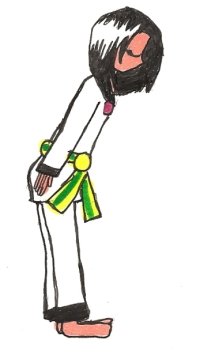Bowing
Beginning Taekwondo students often do not understand the traditional practice of bowing to authority figures, training partners, national flags, and sparring opponents. So perhaps a word (or several) is in order.
 Student Bowing, by Kathryn Lichlyter |
Why should I bow? In many countries, bowing is the equivalent of handshaking in other countries. It is a sign of respect. Traditionally, your bow shows the recipient that you respect and trust him or her; in return, the recipient bows as way of saying, “I appreciate and reciprocate your feeling.”
How do I bow properly? Traditionally, Taekwondo students bow by standing in front of the recipient and bending from the waist at about a 30-40 degree angle for three to five seconds. Their hands are at their sides, and their eyes are on the ground. Some dojangs have students bow to their national flag in the same way, but putting the right hand on the heart.
|
There are variations to this bow. One is the use a “hammer fist” – in which the student puts a clenched fist on an open palm. In some cultures, this symbolizes the ability to fight combined with the philosophy of avoiding the fight.
In some martial arts (including Karate), you may see students keep their eyes on the person to whom they are bowing. While this may be acceptable in some schools, traditionally in Taekwondo you do not look at the person receiving the bow. As one Taekwondo master I knew stated, "If I can't trust you enough to take my eyes off of you for a few seconds, why would I want to bow to you?"
To whom to I bow, and when? Your best procedure is to follow the example of your instructor and the other students in your dojang. But here is a partial list:
- Bow at the entrance of your school when entering or leaving the dojang for a practice/workout.
- Bow when entering or leaving the training room, bow to the flag (with your hand on your heart if is the custom at your school), and then bow to the instructor. Make sure also to greet your instructor with an appropriate "Good morning, sir,” or “Good evening, ma’am,” upon both entering and leaving.
- Bow when you see senior students (students ranking higher than you), and greet them as well. It is not necessary to bow every time you see them except in classroom situations.
- Bow both before and after an exercise or drill in which you are partnered with a fellow student.
- Before sparring or competition, both players bow to the referees or judges, to their coaches, and to one another.
- Bow when a master instructor walks into the dojang when you are practicing.
- Bow when you are introduced to another master instructor during an event such as a test or tournament.
- Bow when entering or leaving a master instructor’s office (as appropriate to the school).
- Bow at other formal occasions where it may be called for, both inside and outside the school.
When should I not bow?
- If you encounter a senior belt or instructor out of uniform and outside the dojang, you usually do not bow. However, if that person initiates a bow, respond properly.
- If a junior belt fails to bow to a senior belt, the senior belt is not obligated to bow, but should correct the junior belt appropriately.
- In an informal setting, such as a party or dinner hosted by the dojang, students who are not required to be in uniform typically do not have to bow. Check with your school.
AND…
In a true self-defense situation, taking your eyes off your attacker may not prove to be a good idea, There have been stories of martial art students who bowed to their opponents to intimate them and thus avoid a physical altercation; however, this technique is not recommended. Read more on Self- Defense here.
Taekwondo Instructors and Schools: Link your school website to Taekwondo-guide.com as a resource for your students.